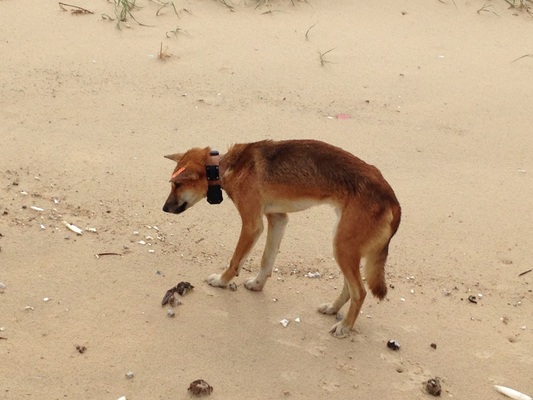By MEGAN OGLE
NEW concerns have been raised over the wellbeing of the Fraser Island dingo population as visitors are expected to flock to the island during the school holidays.
On Monday (21 March), a concerned tourist sent photos to Noosa Today of a dingo they said looked to be emaciated, chaffing from a “heavy” tracking collar, and laden with an ear tag that could impact it’s hunting ability.
Cheryl Bryant a spokeswoman for advocacy group Save Fraser Island Dingoes said the photos were “sad” and “distressing” and that the condition of the animal indicated how the dingoes on Fraser Island were treated.
Ms Bryant said the condition of the dingo was “appalling” and raised concerns about the impact of visitors on the island that had led to dingoes being labelled as aggressive.
“Dingoes are not aggressive by nature but are extremely curious and notorious thieves.
“It is not unusual for the animals to be attracted to the aroma of cooking food, bait buckets or open eskies,” Ms Bryant said.
“This behaviour should not be considered a sign of aggression or treated as an ‘incident’. The term implies the animal is acting out of character, which is not the case.”
Ms Bryant said the expected influx of visitors to the Island during the school holiday period could have a damaging impact on the local dingo population.
“During the Easter holidays the dingo will again be put under pressure by the enormous influx of tourists.
“Over 15,000 vehicle permits were issued for Fraser Island between December and the end of February – an increase of more than 2500 vehicles for the same period the previous year,” she said.
“Easter is also the commencement of the dingo breeding season.
“The chances of a dingo encounter over this holiday period is likely. If tourists abide by the guidelines and do not attempt to interact with or feed the animals, then Easter on Fraser Island can be a positive and safe experience for both tourists and wildlife.”
A Queensland Parks and Wildlife Services (QPWS) spokesperson said except for the chafing, the dingo pictured was in “good health”.
The spokesperson said the tracking collars are approved for use, are light-weight and are used to track dingoes that have been associated with “high risk” interactions with humans.
“(The collars) have been designed specifically for use on dingoes and other mid-sized mammals,” the spokesperson said.
“Dingoes on Fraser Island that occupy areas around townships and high-use visitor sites and are frequently interacting with visitors are ear-tagged for identification purposes (and tracking) does not occur on dingoes less than 10kg.
“This particular dingo had an aggressive history which is why it was being tracked.
“Its interactions with humans had been getting increasingly serious, beginning with loitering in visitor areas and progressing to biting people.”
Ms Bryant said she was shocked the rangers had allowed the dingo to get to such a state but the QPWS spokesperson said rangers had intended to recapture the animal and assess the cause of the chafing on its neck.
Sadly, both the QPWS and Save The Fraser Island Dingo group confirmed the dingo in the pictures had been killed on Friday 25 March when it was believed to have been hit by a car.
“This male dingo died on Good Friday (25 March),” the QPWS spokesperson said.
“Preliminary necropsy results confirm the dingo was hit by a vehicle on the beach. Rangers are investigating. The vet report indicated the collar had resulted in minor dermatitis.”
Ms Bryant said: “Education, respect and understanding are crucial if we are to preserve and protect the future of the Fraser Island dingo.”








